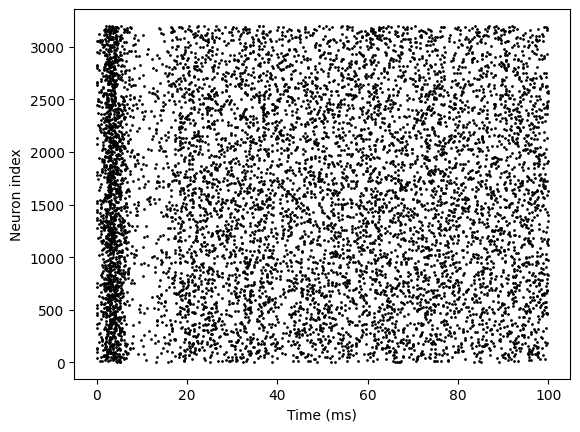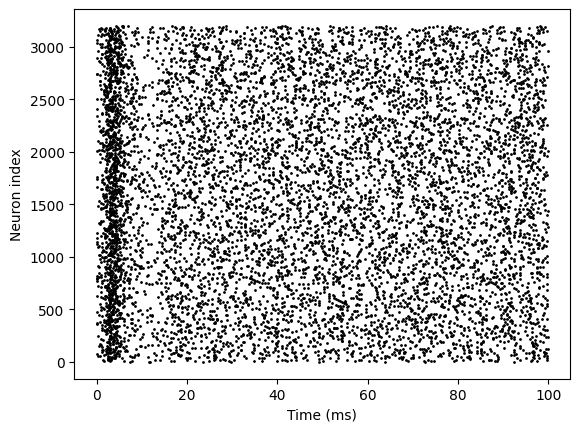(Brette, et, al., 2007) CUBA
Implementation of the paper:
Brette, R., Rudolph, M., Carnevale, T., Hines, M., Beeman, D., Bower, J. M., et al. (2007), Simulation of networks of spiking neurons: a review of tools and strategies., J. Comput. Neurosci., 23, 3, 349–98
which is based on the balanced network proposed by:
Vogels, T. P. and Abbott, L. F. (2005), Signal propagation and logic gating in networks of integrate-and-fire neurons., J. Neurosci., 25, 46, 10786–95
Authors:
[1]:
import brainpy as bp
import brainpy.math as bm
import numpy as np
bp.math.set_platform('cpu')
[2]:
bp.__version__
[2]:
'2.4.4.post1'
Old version
[3]:
class CUBA(bp.DynSysGroup):
def __init__(self, scale=1.0, method='exp_auto'):
# network size
num_exc = int(3200 * scale)
num_inh = int(800 * scale)
# neurons
pars = dict(V_rest=-49, V_th=-50., V_reset=-60, tau=20., tau_ref=5.,
V_initializer=bp.init.Normal(-55., 2.))
E = bp.neurons.LIF(num_exc, **pars, method=method)
I = bp.neurons.LIF(num_inh, **pars, method=method)
# synapses
we = 1.62 / scale # excitatory synaptic weight (voltage)
wi = -9.0 / scale # inhibitory synaptic weight
E2E = bp.synapses.Exponential(E, E, bp.conn.FixedProb(0.02),
g_max=we, tau=5., method=method)
E2I = bp.synapses.Exponential(E, I, bp.conn.FixedProb(0.02),
g_max=we, tau=5., method=method)
I2E = bp.synapses.Exponential(I, E, bp.conn.FixedProb(0.02),
g_max=wi, tau=10., method=method)
I2I = bp.synapses.Exponential(I, I, bp.conn.FixedProb(0.02),
g_max=wi, tau=10., method=method)
super(CUBA, self).__init__(E2E, E2I, I2E, I2I, E=E, I=I)
[4]:
# network
net = CUBA()
[5]:
# simulation
runner = bp.DSRunner(net,
monitors=['E.spike'],
inputs=[('E.input', 20.), ('I.input', 20.)])
runner.run(100.)
[6]:
# visualization
bp.visualize.raster_plot(runner.mon.ts, runner.mon['E.spike'], show=True)

New version (>= 2.4.0)
[7]:
class ExponCUBA(bp.Projection):
def __init__(self, pre, post, prob, g_max, tau):
super().__init__()
self.proj = bp.dyn.ProjAlignPostMg2(
pre=pre,
delay=None,
comm=bp.dnn.EventCSRLinear(bp.conn.FixedProb(prob, pre=pre.num, post=post.num), g_max),
syn=bp.dyn.Expon.desc(post.num, tau=tau),
out=bp.dyn.CUBA.desc(),
post=post,
)
[8]:
class CUBA_Net(bp.DynSysGroup):
def __init__(self, scale=1.0):
super().__init__()
# network size
num_exc = int(3200 * scale)
num_inh = int(800 * scale)
# neurons
pars = dict(V_rest=-49, V_th=-50., V_reset=-60, tau=20., tau_ref=5.,
V_initializer=bp.init.Normal(-55., 2.))
self.E = bp.dyn.LifRef(num_exc, **pars)
self.I = bp.dyn.LifRef(num_inh, **pars)
# synapses
we = 1.62 / scale # excitatory synaptic weight (voltage)
wi = -9.0 / scale # inhibitory synaptic weight
self.E2E = ExponCUBA(self.E, self.E, 0.02, g_max=we, tau=5.)
self.E2I = ExponCUBA(self.E, self.I, 0.02, g_max=we, tau=5.)
self.I2E = ExponCUBA(self.I, self.E, 0.02, g_max=wi, tau=10.)
self.I2I = ExponCUBA(self.I, self.I, 0.02, g_max=wi, tau=10.)
def update(self, inp):
self.E2E()
self.E2I()
self.I2E()
self.I2I()
self.E(inp)
self.I(inp)
return self.E.spike, self.I.spike
[9]:
# network
net = CUBA_Net()
[10]:
# simulation
indices = np.arange(1000) # duration 100 ms
e_sps, i_sps = bp.math.for_loop(lambda i: net.step_run(i, 20.), indices, progress_bar=True)
[11]:
# visualization
bp.visualize.raster_plot(indices * bm.get_dt(), e_sps, show=True)

